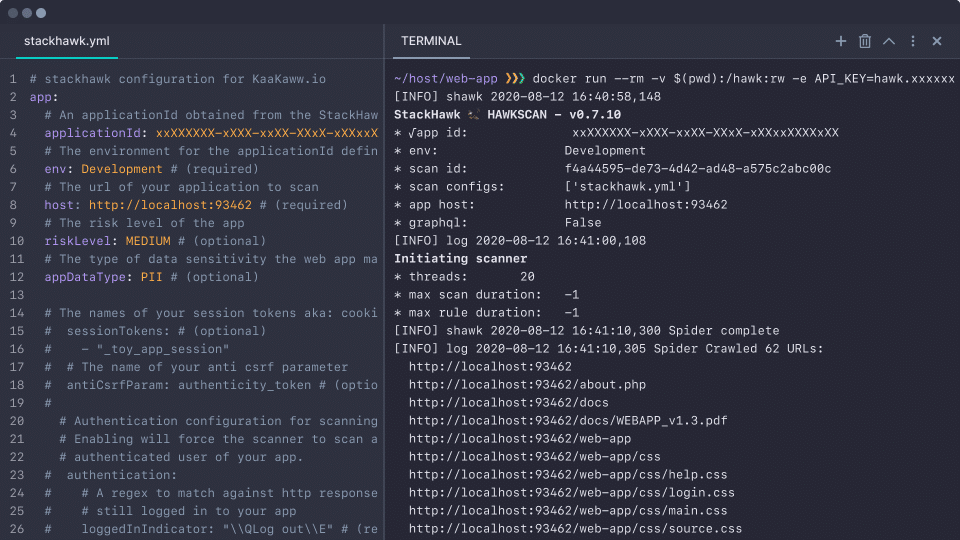When it comes to dynamic application security testing (DAST),ZAPis the industry standard. As anopen-source tool, it has developed significant popularity among security teams and penetration testers.
However, if you want to scale application and API security across a software team, StackHawk takes the cake. StackHawk is the leading dynamic application security testing tool for modern engineering teams. Built on top of ZAP, StackHawk takes the power of ZAP’s scanning and makes it simple to automate and scale throughout engineering.
tl;dr: StackHawk vs. ZAP
Below is a quick teardown of ZAP vs. StackHawk 👇. Be sure to read on for more details!

Key Differences Between ZAP and StackHawk
DAST Scanner Comparison
When using StackHawk for application security testing, you can ensure that you have a trusted scanner with an ever-improving suite of security tests. In addition to that, StackHawk provides additional key benefits:
Technology Flags for Scan Scoping: When configuring an application for scanning in StackHawk, you can select the underlying technologies used within the application. This ensures that the scanner only runs tests that are relevant to your application architecture, reducing scan times and false positives.
Scanner Performance: StackHawk has optimized ZAP’s performance to ensure that tests run quickly and successfully every time. As big believers in automated DAST in CI/CD, StackHawk knows that your security tests must be highly performant and has done the leg work for you.
Further Optimization Tips: StackHawk helps identify any optimization opportunities you might be missing out on while testing your applications. The Optimization Tips panel highlights the enablement status of three key features, custom scan discovery , technology flags , and authentication , on every scan.
Automating DAST in CI/CD

Gone are the days of scheduled scans or reliance on periodic penetration testing. Modern software teams know that application security testing must be automated in CI/CD .
StackHawk is built for automation and makes it simple to automate at scale . Below are the key benefits that automation with StackHawk provides:
Configuration as Code: StackHawk is configured via a YAML file , which means that your security testing can have the same version control you already rely on. Plus, with YAML overlays , it is simple to leverage shared configuration across multiple test environments.
Finding Triage to Manage Findings: When your scan finds a potential vulnerability, you have the choice of fixing it at that moment or putting it in a triaged state within the StackHawk platform. When you send a finding to your issue tracking tool such as Jira, or mark it with a status such as Risk Accepted, the scanner will no longer break the build for that particular finding.
Finding History and Documentation: With StackHawk, you have a simple interface to review scan history, finding history, and documentation of selected actions. This allows security teams to maintain visibility while scaling application security.
Managed Docker Deployment to Scan Anywhere: StackHawk is deployed via Docker , which makes it simple to scan your application, regardless of where it is running.
Authenticated Scanning: Running automated, authenticated scans is simple with StackHawk. We support cookie-based, bearer-token, and external token auth. Check out our authentication docs or chat with our support team for more information.
Developer Experience for Scaling AppSec

Scaling application security and shifting left require developer involvement in the application security testing process. With modern DevOps (or DevSecOps) pipelines, a developer is alerted with a broken build if their latest changes don’t pass unit tests or integration tests. Security should be no different.
A key difference between ZAP and StackHawk is the developer experience when a potential vulnerability is identified. StackHawk makes it simple to roll out application security testing across the engineering organization, resulting in shorter fix times and an increased ability to deliver secure applications and APIs.
Platform User Experience: StackHawk is a developer-first application security testing tool. The StackHawk UI equips engineers and security professionals alike with the ability to quickly understand a finding with vulnerability overviews, links to fix documentation, and the request / response evidence for the vulnerability.
Fixes Simplified with Docs and cURL Commands: As with any bug, security vulnerabilities are easiest to fix when the developer is in the context of the code they were just working on. With StackHawk, a developer is alerted when a new potential vulnerability is found. Then, the platform provides fix documentation, the request / response evidence of the finding, and a cURL command generator to recreate the same request.
Correlated Findings: StackHawk gives developers the ability to identify critical issues in their code by correlating DAST and SAST findings through integrations with Snyk Code and GitHub CodeQL . This allows teams to reduce noise and accelerate fix times by identifying which vulnerabilities are exploitable at runtime and where they exist in the codebase.
Engineering Workflow Integrations: StackHawk provides integrations with popular engineering tools, such as GitHub , Jira , Datadog , Slack , and more, making security testing a natural extension of the developer workflow. By tying into tooling the engineering team already uses, scaling application security has never been easier.
Building vs. Buying Your AppSec Tools
With the ZAP open-source scanner at the core of StackHawk, it is no secret that your team could technically accomplish similar testing without purchasing StackHawk. Ultimately, it comes down to whether you want to invest a lot of time and resources in building functionality around ZAP to automate and scale the application security testing or if you would prefer to implement a tool that has already done the work for you.
Last but certainly not least, StackHawk has a highly responsive support team to guide you through implementation and help with any issues that you may encounter.

So go ahead – get started with a StackHawk trial or free account today.
